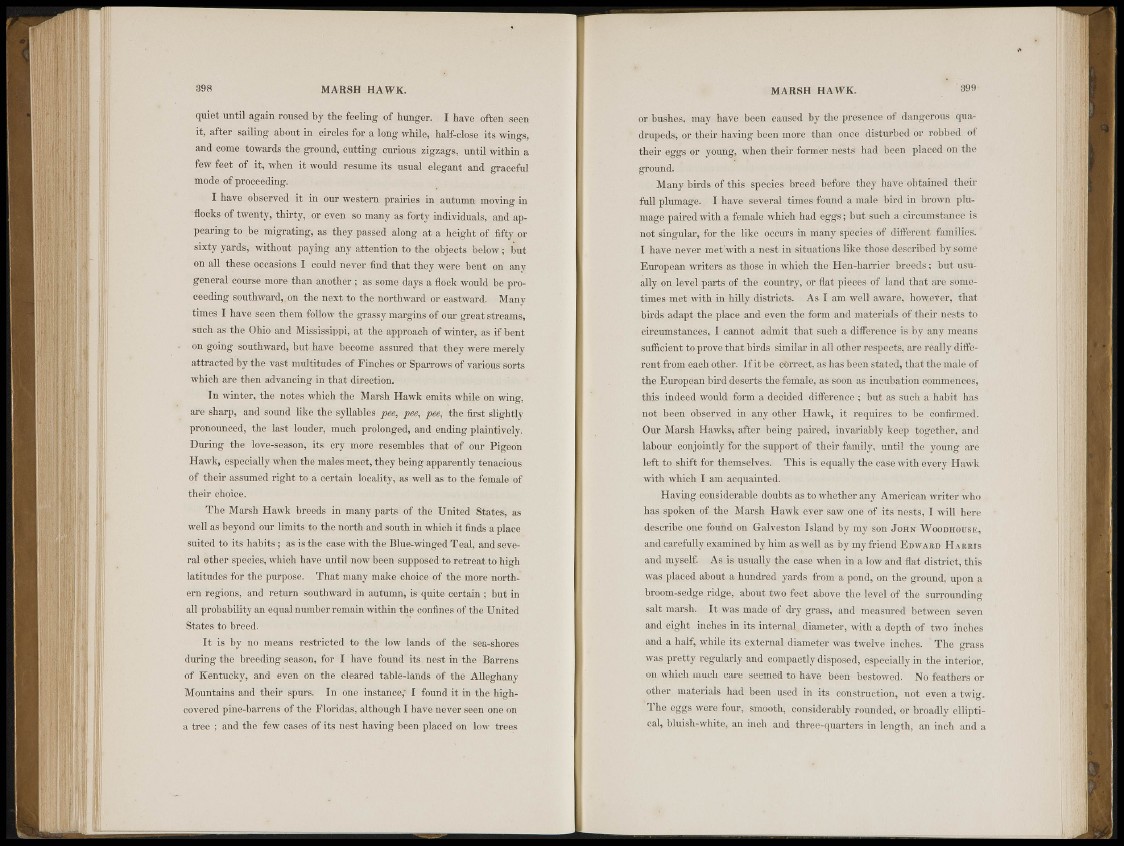
398 MARSH HAWK.
quiet until again roused by the feeling: of hunger. . I have; often seen
it, after sailing about in circles for a long while, half-close its wings,
and come towards the ground, cutting curious zigzags, until within a
few feet of it, when it would resume its usual elegant and graceful
mode of proceeding.
I bare observed it in our western prairies in autumn moving in
flocks of twenty, thirty, or even so many as forty individuals, and appearing
to he- migrating, as they passed along at a height of fifty or
sixty yards, without paying any attention to the objects below ; but
on all these occasions,could never find that they were bent: mi any
general course more than another 5 as some days a flock would be proceeding
southward,,on the next to the northward or eastward. Many
times I have: seen thorn follow the grassy margins of our great streams,
such as the Ohio and Mississippi, at the approach of winter,, as if bent
on going southward, but have become assured that they Were merely
attracted by the vast multitudes of Finches or Sparrows of various sorts
which aré then advancing in that direction.
In winter, the notes which the Manb Hawk emits while on wing,
are sharp, and sound like tlm syllables jm, pen, pee, the first slightly
pronojjgced, the last louder, much prolonged, and ending plaintively.
During the love-season, its cry more .resembles that of our Pigeon
-'Hawk, especially S Í ® the males meet, they being apparently tenacious
of their assumed right to à certain locality, as well as to the female of
their choice.
The Marsh Hawk breeds in many parts of the United States, as
well as beyond our limits to the north and south in which it finds a place
suited to its habits ; as is the case with the Muetwinged Teal, and several
other species, which have until now been supposed to retreat to high
latitudes for the purpose. That many make choice of the more northem
regions, and return southward in autumn, is quite certain ; but in
all probability an equal number remain within the confines of the United
States to breed.
It is by no means restricted to the low lands of the sea-shores
during the breeding season, for I have found its. nest in the Barrens
of Kentucky, and even on the cleared table-lands of the Alleghany
Mountains and their spurs. In one instance," I found it in the highcovered
pine-barrens of the Floridas, although I have never seen one on
a tree ; and the few cases of its nest having been placed on low trees
MARSH HAWK. 399
or bushes, may-have been caused by the presence of dangerous quadrupeds.
or their having been more than once disturbed or robbed, of
their eggs or young, when their former nests had been placed on the
ground.
Many birds of this species breed before they have obtained their
full plumage. I. have several times found a male bird in brown plumage
paired with a female which had egg*; but such a circumstance is
not singular, for the like occurs in many speeiés of different families:'
I have never met'with a nest in situations like fllosfl described by some
European writers as those in which the Hen-harrier breeds; but usually
on level parts of the country, or fiat pieces of land that are sometimes
met with in hilly districts. As-1 am well aware,; .howeter, that
birds adaptjtbe place and even the form and materials of their nests to
circumstances, I cannot admit that such a difference is by any means
sufficient to prove that birds similar in all other respects, are really different
from each other. If it be correct, as has been stated, that the male of
the European bird deserts the female,yas: soon as incubation commences,
this indeed would form a decided difference ; but as such a habit has
not been observed in any other Hawk, it requires, to be confirmed.
Our Marsh Hawks, after being paired, invariably keep together,' and
labour conjointly for the support of their family, until the. young are
left to shift for themselves. This is equally the case with every I lawk
with which I am acquainted.
Having considerable doubts as to whether any American writer who
has spoken of the Marsh Hawk ever saw one of its nests, I will here
describe one found on Galveston Island by my son JOHJ J WOODHOUSE,
and carefully: examined by him as well as by my friend E DWA R D HARRIS
and myself. Assis usually the case when in a low and flat district, this
was placed about ahundred yards from a pond, on the ground, upon a
bruuiu-sedgc ridge, about two feet, above the level of the surrounding
salt marsh. It Was made of dry grass, and measured between seven
and eight, inches in its internal, diameter, with a depth of two inches
and a half, while its external . diameter was twelve inches, The grass
was pretty regularly and. compactly disposed, especially in the' interior,
which much care seemed to; have been bestowed. No feathers or
other materials had been used in its construction, not even a twig.
The eggs wore four, smooth, considerably rounded, or broadly elliptical,
bluish-white* an inch and three-quarters in length, an inch and a